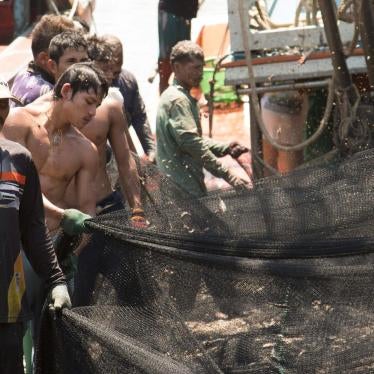Human Rights Watch released the results of a 2-year investigation of allegations that a chemical agent was used against Bosniaks fleeing Srebrenica during the war in Bosnia and Hercegovina in July 1995.
Short of conclusive evidence that a chemical agent was used, Human Rights Watch called today for a broader international investigation of the allegations in order to bring justice to the victims, strengthen international controls over the proliferation of chemical weapons, and prevent a dangerous arms race in the former Yugoslavia.
While the 54-page report, Chemical Warfare in Bosnia? The Strange Experiences of the Srebrenica Survivors, does not present conclusive proof substantiating the allegations, Human Rights Watch has documented the following:
In the summer of 1995, shortly after the fall of the United Nations-designated "safe area" of Srebrenica, survivors emerged from a long trek to safety with accounts that they had been attacked during their flight with some type of chemical weapon, possibly an incapacitating agent called BZ. (This agent was originally developed by the United States in the 1960s but was never used). Their column had been attacked by Bosnian Serb forces commanded by Gen. Ratko Mladi.
Survivors gave consistent descriptions to Human Rights Watch of mortar shells that produced a "strange smoke" of various colors which did not rise but spread out slowly. Following these attacks, some of the marchers—the numbers are unclear—began to hallucinate and behave in an irrational manner, with some even killing their friends or themselves. So far the behavior following these attacks has defied explanation, including by experts on war-related stress.
The army of the former Yugoslavia, the Yugoslav People's Army (JNA), is known to have possessed incapacitating agents, including BZ, and to have developed doctrine and delivery systems for BZ. The situation that confronted the people fleeing Srebrenica matched the scenario for which the use of incapacitating chemical agents was prescribed in a JNA military manual.
The United States government apparently took the allegations seriously enough to conduct an investigation, reported to have taken place in late 1996 or early 1997. The results of this investigation have not been made public, but in late 1996 or early 1997 the U.S. intelligence community was reported to have information suggesting that chemical weapons may have been used in Srebrenica. The U.S. government's refusal to release the findings may, according to a U.S. official interviewed by Human Rights Watch, be based on a belief that making this information public might hurt the international effort to effect peace in the former Yugoslavia.
Following interviews with some thirty-five survivors as well as U.N. and other international personnel in the former Yugoslavia, and a review of documentation available in 1996-97 relating to events at Srebrenica, Human Rights Watch has found the evidence, while suggestive of the use of BZ or a similar chemical incapacitant, still incomplete. Most of those reported to have been affected by the "strange smoke" apparently never reached Tuzla and could therefore not be interviewed; they are presumed dead. Physical evidence, including chemical traces in shells or the clothes of people who died during the march and whose bodies were exhumed subsequently, has remained elusive.
In a March 1997 report, Clouds of War: Chemical Weapons in the Former Yugoslavia, Human Rights Watch disclosed that it had uncovered evidence that the JNA had an extensive and sophisticated chemical weapons program prior to the breakup of Yugoslavia in 1991 that included nerve and mustard gasses, but also incapacitating agents like BZ; that the army of the Federal Republic of Yugoslavia (Serbia and Montenegro) inherited much of this program; and that the army of Bosnia and Hercegovina produced crude chemical munitions during the Bosnian war (1992-95).
Human Rights Watch also revealed that it had strong indications that the army of the Federal Republic of Yugoslavia was continuing to maintain an offensive chemical weapons capability throughout the 1990s. The Federal Republic of Yugoslavia is the only state in Europe not to have signed the 1993 Chemical Weapons Convention.
As sponsor of the Dayton Accords, the international community has a vital stake in the accords' success. Silence on the question whether Serb forces used chemical weapons will give the perpetrators a sense of impunity, and may therefore encourage them to resort to chemical weapons again in any future fighting. Moreover, Yugoslavia's failure to sign the Chemical Weapons Convention may undermine treaty compliance by other Balkan states.
Human Rights Watch calls on the international community to investigate allegations that chemical weapons were used in Srebrenica. The U.N. Security Council should instruct U.N. agencies, such as the Organization for the Prohibition of Chemical Weapons, the International Criminal Tribunal for the Former Yugoslavia, and the Office of the United Nations Secretary-General, to do so. It should also call for the release of all information on the development, production, stockpiling, and use of chemical weapons in the former Yugoslavia which international alliances and their member states, including troop contributors of the now-defunct United Nations Protection Force (UNPROFOR) and NATO-led Implementation Force (IFOR), as well as the Stabilisation Force (SFOR) and the International Police Task Force (both currently operating in Bosnia), may have in their possession.









